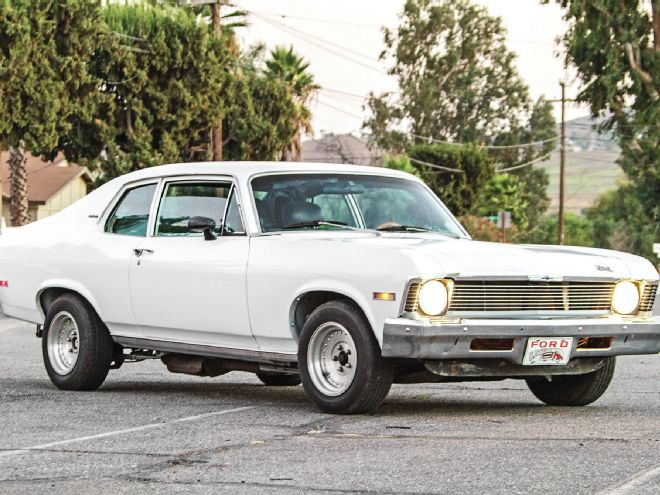
High school teacher Michael Bees has owned his 1974 Nova hatchback for more than 10 years. Originally purchased as a rolling shell without an engine or a trans, it went through several small-blocks and 700-R4 automatics. When the latest small-block developed a rod knock, Bees swapped in a salvage-yard 2004 Tahoe 4.8L EFI LS-type engine and 4L60E automatic overdrive trans using Street & Performance conversion parts. Bringing up the rear is a 3.73:1-geared 10-bolt with an Eaton Posi and Sierra axles.
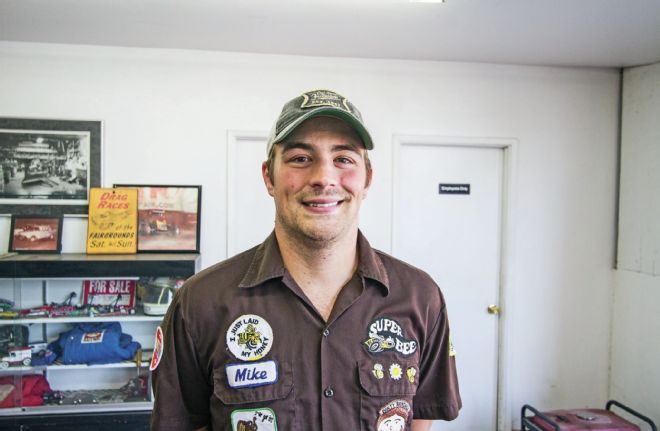 Mike Bees says his low-buck 1974 Nova was “built by me and my old roommate over dirt, rocks, broken concrete, and under a tree.”
Mike Bees says his low-buck 1974 Nova was “built by me and my old roommate over dirt, rocks, broken concrete, and under a tree.”
Some time after installation, the car developed what Bees describes as an “intermittent screaming noise. It makes the noise 80–90 percent of the time. I thought it was the transmission, but a local trans shop said it was not the trans but the brake booster. The brake shop said it wasn’t the booster, but couldn’t figure it out, either. I am at a loss since most shops don’t want to look at anything that’s not stock.” The queen Bees—Mike’s wife—kept pushing him to sell it, “but I just want to drive it. Please help me get it back on the road to keep the gearhead DNA flowing!”
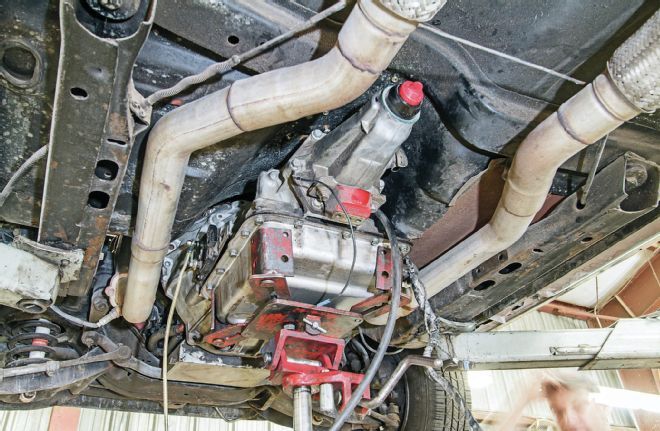 After eliminating all other possible sources, the drone was traced to an issue with the transmission, torque converter, and fluid lines.
After eliminating all other possible sources, the drone was traced to an issue with the transmission, torque converter, and fluid lines.
Coincidentally, Bees lives only about a mile away from Mark Sanchez’s Advanced Engineering West (AEW) shop in Mira Loma, California. Although Sanchez is primarily a Ford specialist, due to his proximity to Bees (“We’re practically neighbors!”), he agreed to evaluate the car and perform the initial diagnostics. Later, Rollings Automotive got involved for the heavy wrenching. A scarce holdout among a vanishing breed, Rollings is a full-service shop capable of doing everything from late-model stocker repairs to complete frame-up custom street rod and hot rod projects. It also builds or rebuilds complete engines, transmissions, and rearends. Owner Norm Rollings says he’s “been doing this for 40 years now. We try to be the mechanic’s mechanic.” Also brought in for a consult was Julian Nieto, owner of Four C’s Transmission Specialty. Nieto is a real problem-solver when it comes to late-model automatic transmissions. Ultimately, TCI came to the rescue with a complete high-perf 4L60E trans and torque converter—but we’re getting ahead of ourselves.
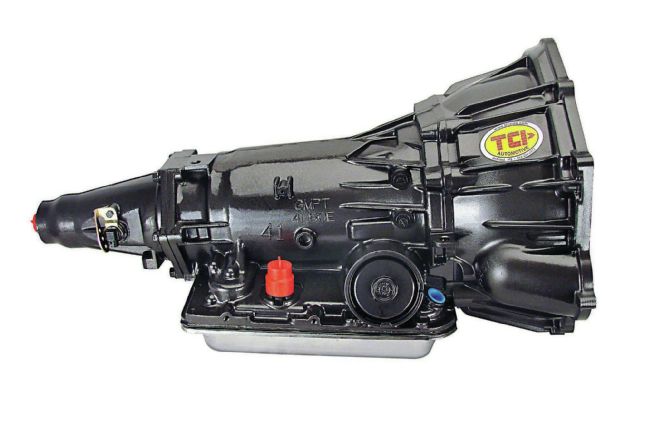 TCI supplied a built, 725hp capacity, 4L60E StreetFighter trans and Breakaway lockup torque converter.
TCI supplied a built, 725hp capacity, 4L60E StreetFighter trans and Breakaway lockup torque converter.
Sanchez first test-drove the car to verify Bees’ complaint, quickly establishing the problem seemed to occur during the 1–2 shift. It was indeed intermittent if the car was allowed to upshift automatically in Drive. But to consistently replicate the problem, Sanchez says he “had to manually shift the car. Speed or rpm were not a factor.” To Sanchez, the noise “sounded like a constant tapping vibration or buzzing, almost like an extremely loud electronic solenoid buzz.”
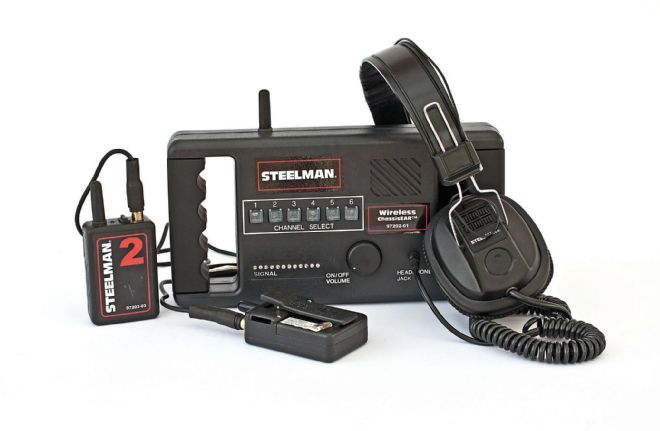 AEW’s Mark Sanchez tied up, wrapped, and isolated any item that could rub against the drivetrain or frame—but it made no difference. He finally traced the noise to the transmission area by using this Steelman Wireless ChassisEAR remote audible listening device. It’s like your Doc’s stethoscope, only wireless and for a car.
AEW’s Mark Sanchez tied up, wrapped, and isolated any item that could rub against the drivetrain or frame—but it made no difference. He finally traced the noise to the transmission area by using this Steelman Wireless ChassisEAR remote audible listening device. It’s like your Doc’s stethoscope, only wireless and for a car.
Next, Sanchez put the car up on jackstands to filter out any road-noise feedback or surface-contact harmonics. But driving the car on the stands without the wheels in contact with the road made no difference, either. Sanchez relates that “all the ‘experts’ had claimed it couldn’t be the trans—so next we physically searched for external sources. We wrapped the brake lines, the fuel lines, and the trans lines. We tied loose cables out of the way. In short, we looked for and identified anything that could be rubbing against the drivetrain components or the body. Still no difference.”
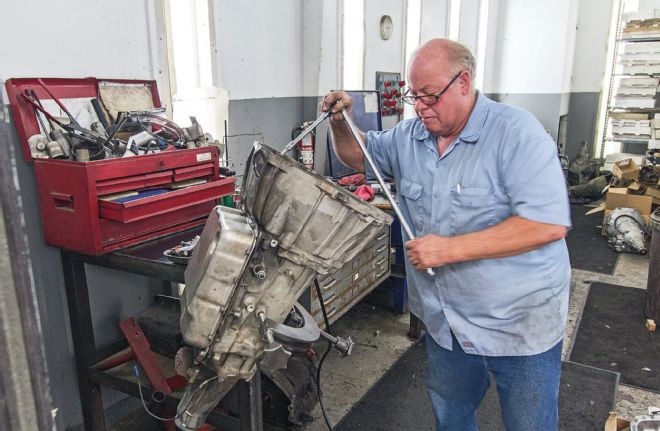 Norm Rollings of Rollings Automotive did the heavy wrenching. He’s been working on stockers and hot rods alike for more than 40 years.
Norm Rollings of Rollings Automotive did the heavy wrenching. He’s been working on stockers and hot rods alike for more than 40 years.
At this point, it was time get out Sanchez’s go-to vibration analysis tool: a Steelman Wireless ChassisEAR remote listening device with clamp-on magnetic sensors. “With the ‘ears’, I could tell that the noise seemed to be coming up from the bellhousing area,” Mark explained. “The intensity scale on the tool went higher when connecting to the bellhousing area compared to the tailshaft, the oil pan, or the trans lines. To me, this indicated a problem with the trans, the torque converter, or even a cracked flexplate.”
With the scope of the problem narrowed, the car went over to Rollings Automotive (also located in Mira Loma) for further inspection, analysis, and teardown. Rollings examined the Nova and saw that the trans cooler lines were poorly routed, bent, and kinked. Checking trans-fluid flow, Norm observed “virtually nothing coming out of the radiator.” He also discovered restrictive screen-style inline fittings installed at the radiator end. Restrictions can cause a hydraulic resonance condition that may have been a cause of the weird noise. But with inconsistent fluid circulation, the long-term longevity of the existing trans and torque converter—salvage-yard takeouts—now also became questionable. The failsafe move was to replace the trans and torque converter. We strongly recommend replacing these units as a pair because if one had a problem, odds are that it sent contaminating debris through the other. Who wants a Rescue replay? Not HOT ROD!
For Bees’ near-stock 4.8L LS truck motor, the good folks at TCI stepped up and sent us its “mildest” StreetFighter 4L60E transmission with an 11-inch Breakaway torque converter. We say “mild” because the combo supports 725 hp; there are TCI 700-R4/4L60E-based transmissions and converters available that support upward of 1,000 hp in full-race trim if you need ’em.
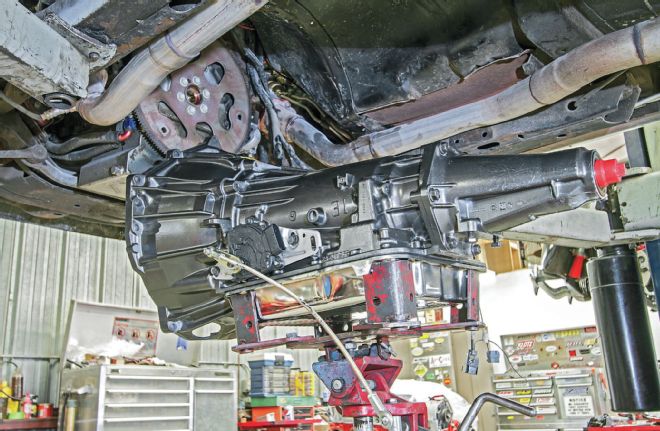 TCI’s 4L60E StreetFighter transmission assembly (PN 371016) is a direct replacement for 4L60E/4L65E transmissions installed behind 2000–2006 4.8/5.3/6.0L LS-style truck engines with the OE computer (like Bees salvage-yard retrofit), compatible aftermarket computer, or TCI’s own stand-alone controller.
TCI’s 4L60E StreetFighter transmission assembly (PN 371016) is a direct replacement for 4L60E/4L65E transmissions installed behind 2000–2006 4.8/5.3/6.0L LS-style truck engines with the OE computer (like Bees salvage-yard retrofit), compatible aftermarket computer, or TCI’s own stand-alone controller.
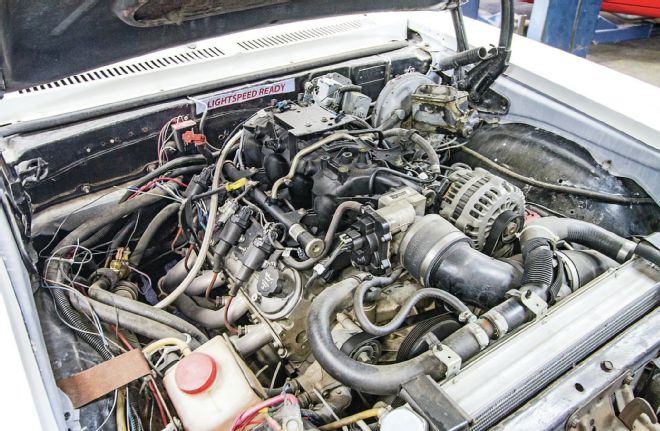 The Nova had been through several traditional small-block engine/trans combos, but Bees finally took the plunge and dropped in a salvage-yard 2004 Tahoe 4.8 L EFI-style engine backed by a 4L60E electronic overdrive trans. He bought the mounts, headers, and trans crossmember from Street & Performance, which also programmed the computer.
The Nova had been through several traditional small-block engine/trans combos, but Bees finally took the plunge and dropped in a salvage-yard 2004 Tahoe 4.8 L EFI-style engine backed by a 4L60E electronic overdrive trans. He bought the mounts, headers, and trans crossmember from Street & Performance, which also programmed the computer.
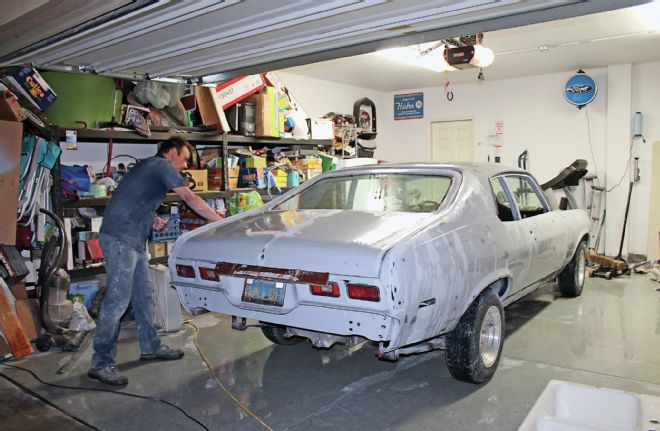 A makeover before that big first date: Bees was so excited HOT ROD approved his Nova rescue request that he prepped and painted the rusty old primered body. The Nova is a 1974 model, altered by Bees to cosmetically resemble a 1973.
A makeover before that big first date: Bees was so excited HOT ROD approved his Nova rescue request that he prepped and painted the rusty old primered body. The Nova is a 1974 model, altered by Bees to cosmetically resemble a 1973.
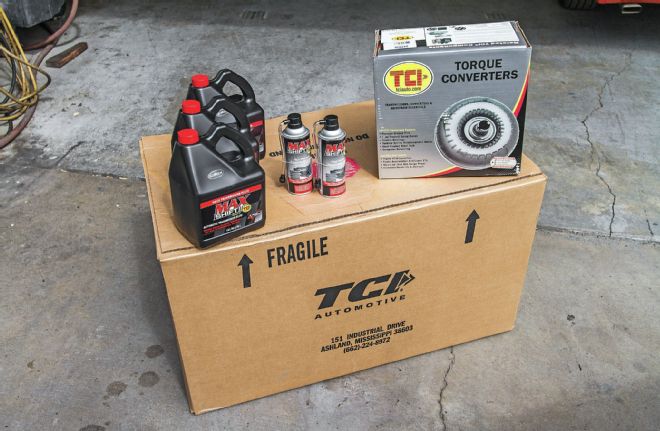 Besides the complete trans in the box, TCI set us everything needed to swap out the questionable assembly: a new Breakaway lockup torque converter, 3 gallons of Max Shift trans fluid, and two cans of trans flush.
Besides the complete trans in the box, TCI set us everything needed to swap out the questionable assembly: a new Breakaway lockup torque converter, 3 gallons of Max Shift trans fluid, and two cans of trans flush.
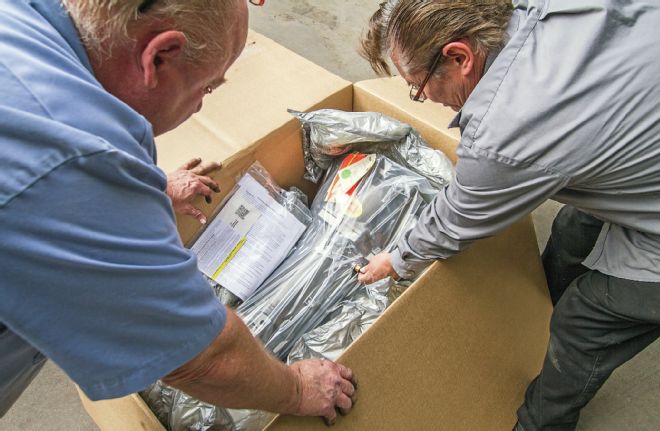 Rollings and Sanchez uncrate the TCI trans.
Rollings and Sanchez uncrate the TCI trans.
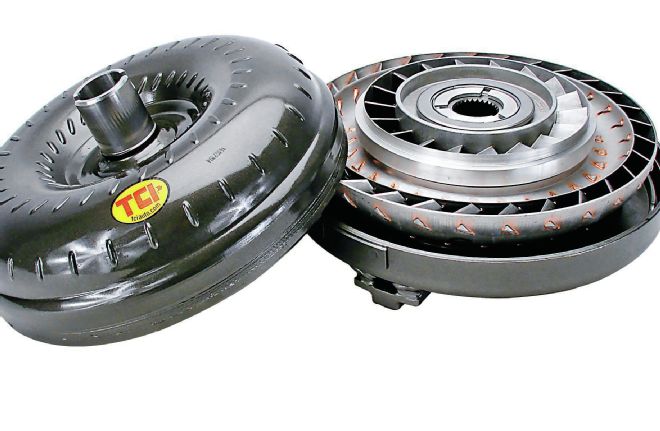 06 06] TCI Breakaway converters’ durability and strength upgrades over stock include furnace-brazed fins; needle bearings; a hardened, preground pump hub; and computer balancing.
06 06] TCI Breakaway converters’ durability and strength upgrades over stock include furnace-brazed fins; needle bearings; a hardened, preground pump hub; and computer balancing.
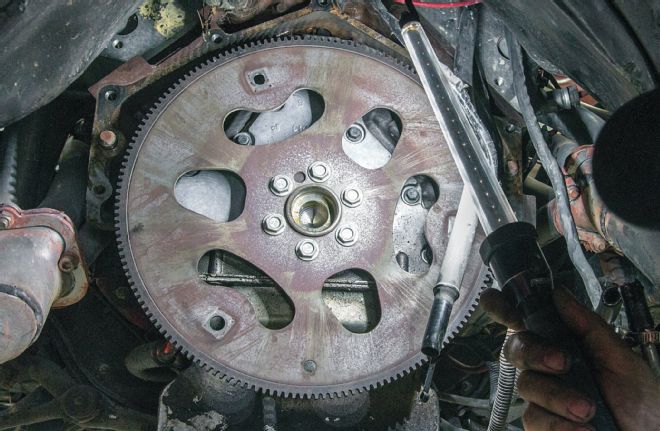 The stock GM flexplate was not a contributor to the noise problem. It wasn’t cracked, and all its mounting bolts were tight. If not, TCI makes SFI-legal flexplates too.
The stock GM flexplate was not a contributor to the noise problem. It wasn’t cracked, and all its mounting bolts were tight. If not, TCI makes SFI-legal flexplates too.
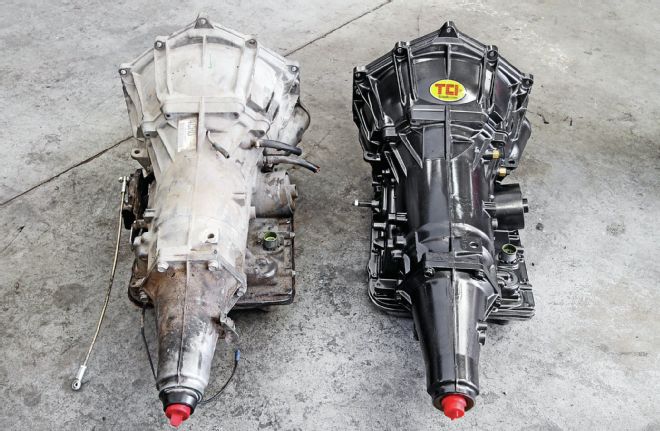 Compare TCI’s trans (right) against Bees’ old salvage-yard takeout (left). As advertised, TCI’s trans and converter were a direct interchange. The separate bolt-on bellhousing and six-bolt extension housing are characteristic of most mid-1990s-and-later 4L60E/4L65E models. There are many variations over the course of the 4L60E’s production run; we advise contacting TCI directly before placing an order. You’ll need to transfer the dipstick and tube, the VSS switch, and the shift-linkage to the new trans. The correct inverted-flate fittings were already on the new unit. Don’t use tapered NPT fittings.
Compare TCI’s trans (right) against Bees’ old salvage-yard takeout (left). As advertised, TCI’s trans and converter were a direct interchange. The separate bolt-on bellhousing and six-bolt extension housing are characteristic of most mid-1990s-and-later 4L60E/4L65E models. There are many variations over the course of the 4L60E’s production run; we advise contacting TCI directly before placing an order. You’ll need to transfer the dipstick and tube, the VSS switch, and the shift-linkage to the new trans. The correct inverted-flate fittings were already on the new unit. Don’t use tapered NPT fittings.
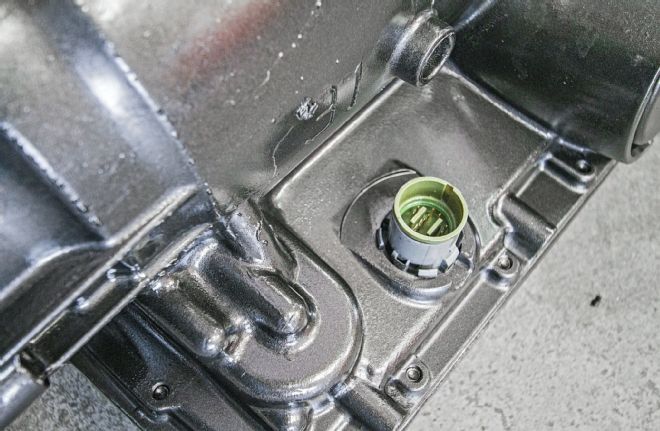 The large, passenger-side, multiprong receptacle is another sign it’s a 4L60E. The “non-E” 4L60 and the 700-R4 still had a TV cable. Different pinouts have been used over the years—make sure the pins on the harness connector match those on the receptacle. Bees’ plug matched. No ECU recalibration was needed, either.
The large, passenger-side, multiprong receptacle is another sign it’s a 4L60E. The “non-E” 4L60 and the 700-R4 still had a TV cable. Different pinouts have been used over the years—make sure the pins on the harness connector match those on the receptacle. Bees’ plug matched. No ECU recalibration was needed, either.
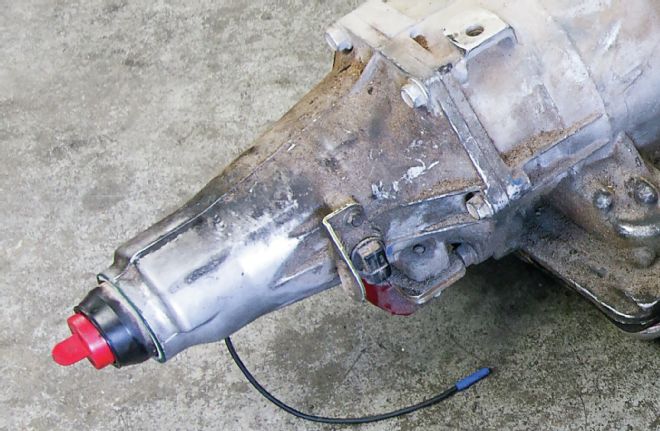 GM has used different vehicle speed sensors (VSS) with varying sampling rates. Generally, an LS-type motor needs a “128K” (128,000 pulses/mile) VSS. The 4L60E lacks mechanical speedometer cable mounting provisions. Bees had already upgraded to an electronic speedometer.
GM has used different vehicle speed sensors (VSS) with varying sampling rates. Generally, an LS-type motor needs a “128K” (128,000 pulses/mile) VSS. The 4L60E lacks mechanical speedometer cable mounting provisions. Bees had already upgraded to an electronic speedometer.
TCI’s StreetFighter transmissions include special clutches and bands for increased durability, plus heavy-duty sprags and roller clutches for increased holding capacity. A modified lubrication system increases fluid volume to the planetaries and other critical transmission internal parts. TCI raises the line pressure for extra-firm shifts and greater torque capacity with less slippage.
TCI Breakaway converters provide approximately a 2,400- to 2,600-rpm flash stall without negatively affecting part-throttle driving. The result is a harder launch and quicker wide-open-throttle (WOT) acceleration even on mild engines without sacrificing part-throttle highway cruise-speed efficiency. As advertised, the trans and converter bolted right in place of Bees’ junkyard truck trans.
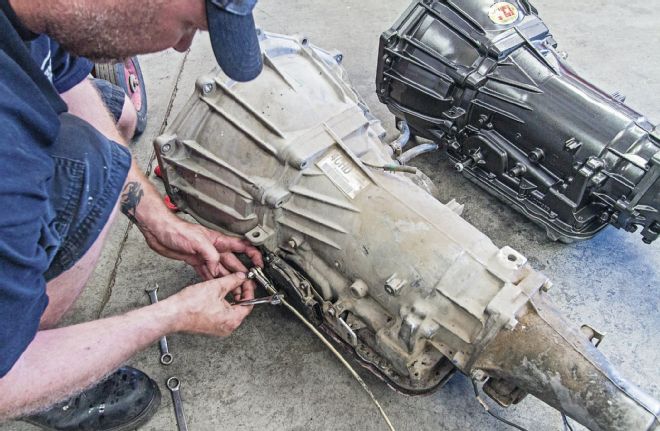 Shift linkage varies per installation. Rollings and crew transferred Bees’ Lokar shift-linkage rod and late-model OE Park/Neutral safety switch onto the new TCI trans.
Shift linkage varies per installation. Rollings and crew transferred Bees’ Lokar shift-linkage rod and late-model OE Park/Neutral safety switch onto the new TCI trans.
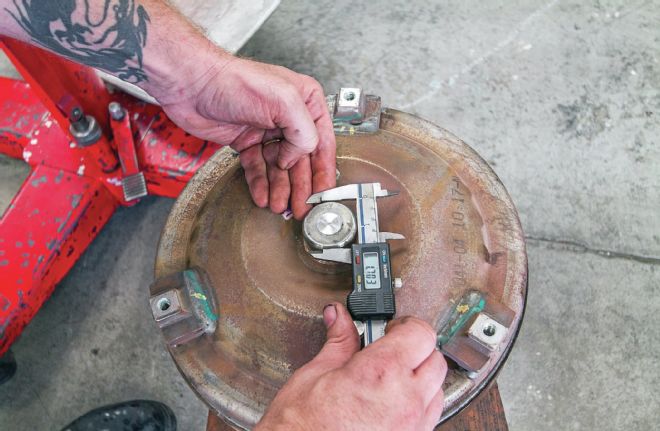 Torque converter pilot hub diameters have varied. Make sure the hub’s diameter is correct for the flexplate and crank. Likewise, the transmission’s input shaft tip configuration has evolved over the years. Be sure the shaft spline count and tip configuration matches the torque converter splines.
Torque converter pilot hub diameters have varied. Make sure the hub’s diameter is correct for the flexplate and crank. Likewise, the transmission’s input shaft tip configuration has evolved over the years. Be sure the shaft spline count and tip configuration matches the torque converter splines.
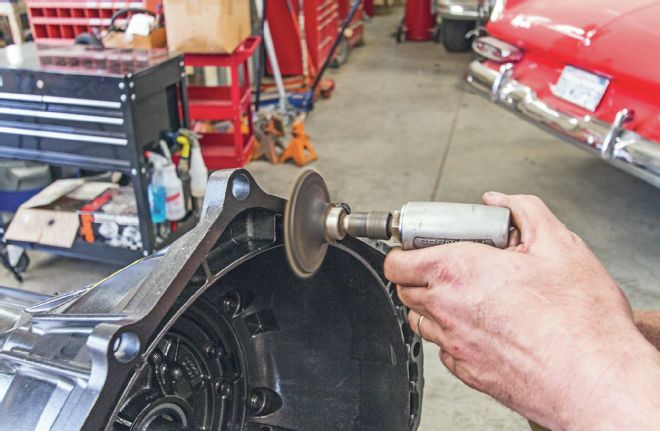 Ground-path integrity is critical on the all-electronic 4L60E. Rollings buffed off the paint on the new TCI tranny’s block mating surface to maximize ground integrity. The ground side always follows the path of least resistance; if the circuit tries to ground out the trans’ back-end, it could arc through and damage the rear bushing, yoke, and driveshaft.
Ground-path integrity is critical on the all-electronic 4L60E. Rollings buffed off the paint on the new TCI tranny’s block mating surface to maximize ground integrity. The ground side always follows the path of least resistance; if the circuit tries to ground out the trans’ back-end, it could arc through and damage the rear bushing, yoke, and driveshaft.
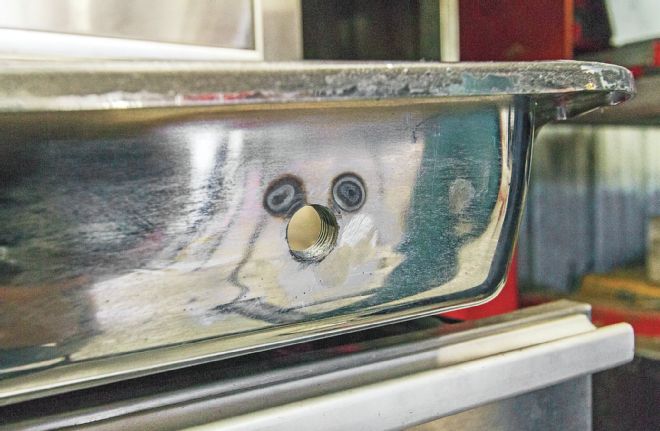 The Nova had a trans-temp gauge. Its sending unit screwed into an inline tee installed on one of Bees’ original fluid lines. “The sensor probe was too short and didn’t go far enough into the oil path to get an accurate reading,” explains Norm. “We modified a universal drain-plug kit to accept the sensor, which now goes directly into a hole drilled in the side of the transmission pan.”
The Nova had a trans-temp gauge. Its sending unit screwed into an inline tee installed on one of Bees’ original fluid lines. “The sensor probe was too short and didn’t go far enough into the oil path to get an accurate reading,” explains Norm. “We modified a universal drain-plug kit to accept the sensor, which now goes directly into a hole drilled in the side of the transmission pan.”
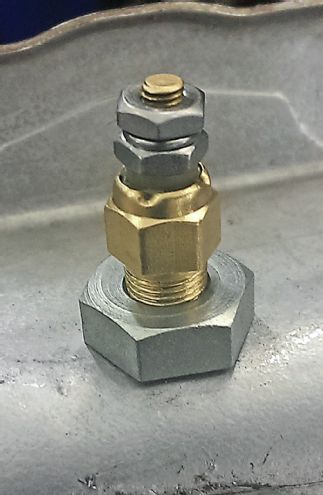 Transmission temperature sensor kits are available from many vendors. The adapter seals via a nut on the inside and a washer on the outside, but Norm says it can come loose. Instead, he welded the fitting into the pan. In this installation, the kit’s 1⁄8-NPT draincock was replaced by the gauge’s sending unit. Just to be safe, Norm also installed a new pan gasket.
Transmission temperature sensor kits are available from many vendors. The adapter seals via a nut on the inside and a washer on the outside, but Norm says it can come loose. Instead, he welded the fitting into the pan. In this installation, the kit’s 1⁄8-NPT draincock was replaced by the gauge’s sending unit. Just to be safe, Norm also installed a new pan gasket.
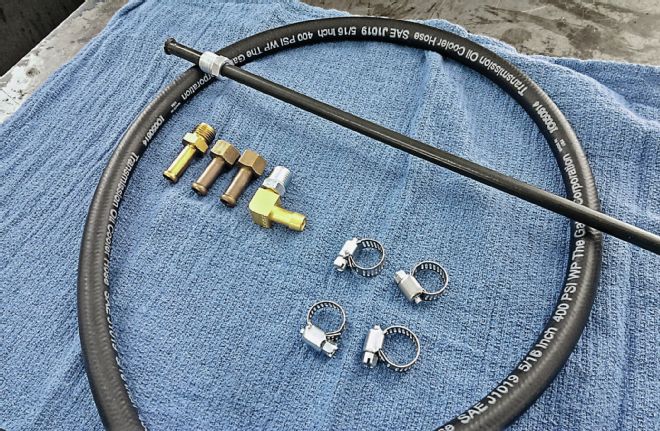 The existing trans cooler lines from the original late-model truck were too long to properly fit in the Nova. They had been hacked, kinked, and twisted trying to make them work.
The existing trans cooler lines from the original late-model truck were too long to properly fit in the Nova. They had been hacked, kinked, and twisted trying to make them work.
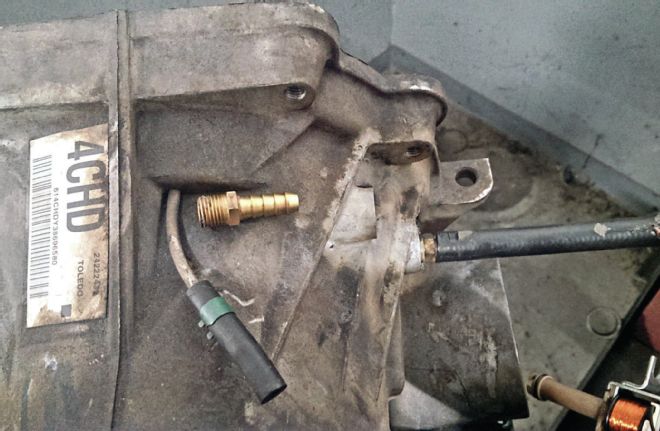 Incorrect national pipe thread tapered (NPT) fluid-line fittings had been installed in the trans. NPT threads are an interference fit. They may leak if screwed into nontapered female threads. Tapered fittings can also crack the trans case under heat-induced expansion.
Incorrect national pipe thread tapered (NPT) fluid-line fittings had been installed in the trans. NPT threads are an interference fit. They may leak if screwed into nontapered female threads. Tapered fittings can also crack the trans case under heat-induced expansion.
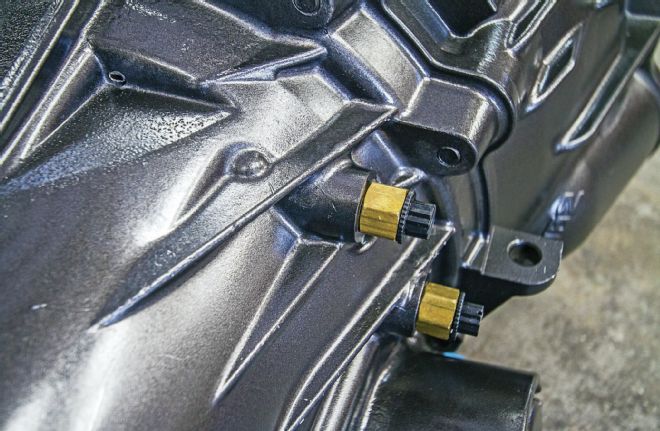 The trans fluid line fittings are a special “weird” national pipe thread straight mechanical (NPSM) nontapered thread that seals via an aluminum crush-washer or thread-locking compound. The pressure-out line is the bottom port; the return line connects to the top fitting.
The trans fluid line fittings are a special “weird” national pipe thread straight mechanical (NPSM) nontapered thread that seals via an aluminum crush-washer or thread-locking compound. The pressure-out line is the bottom port; the return line connects to the top fitting.
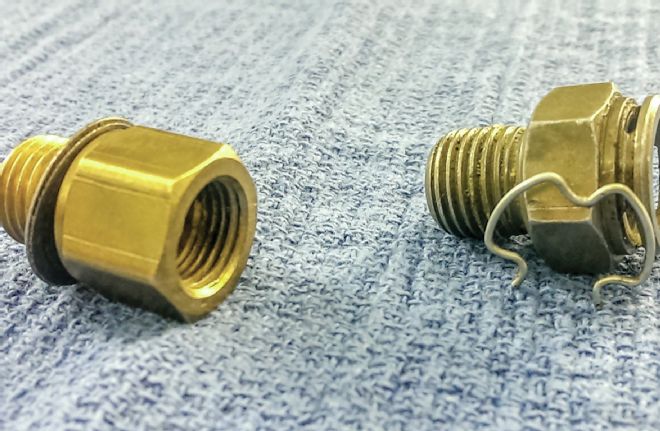 Bees’ late-model 4L60E would have been factory-equipped with Quick-Connects (right) that can be hard to adapt for retrofit installations. Earlier 5⁄16 -inch inverted-flare adapters generally work better. TCI’s trans included 1992-and-earlier 700-R4 fittings with preapplied locking compound. Old TH350/TH400 gasketed fittings (left) also screw in properly.
Bees’ late-model 4L60E would have been factory-equipped with Quick-Connects (right) that can be hard to adapt for retrofit installations. Earlier 5⁄16 -inch inverted-flare adapters generally work better. TCI’s trans included 1992-and-earlier 700-R4 fittings with preapplied locking compound. Old TH350/TH400 gasketed fittings (left) also screw in properly.
 A running engine rocks in the chassis, so proper 400-psi SAE J1019 auto trans hydraulic fluid hose and adapter fittings connect the new steel lines to the radiator’s trans-cooler ports. The car previously had cheap, low-pressure fuel hose at this location. Not really compatible with trans fluid, fuel line can rot out from the inside.
A running engine rocks in the chassis, so proper 400-psi SAE J1019 auto trans hydraulic fluid hose and adapter fittings connect the new steel lines to the radiator’s trans-cooler ports. The car previously had cheap, low-pressure fuel hose at this location. Not really compatible with trans fluid, fuel line can rot out from the inside.
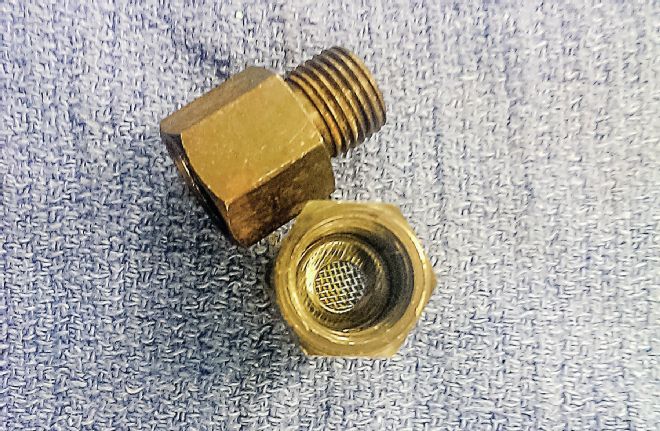 Rollings found screen fittings installed in both radiator cooler ports. They’re restrictive and easily clog. With the engine running (trans front pump operating), Rollings reports “there was no fluid coming out of the radiator.”
Rollings found screen fittings installed in both radiator cooler ports. They’re restrictive and easily clog. With the engine running (trans front pump operating), Rollings reports “there was no fluid coming out of the radiator.”
The Nova had improper tapered pipe-thread fittings in the trans case. Fortunately, the new TCI trans was delivered with proper fittings designed to mate with conventional SAE 45-degree inverted-flare tube-nuts. Rollings bent up new tubing and added short lengths of proper hydraulic hose up front going into the radiator cooler to compensate for engine rock.
Rollings thoroughly flushed the trans radiator and cooler using TCI Trans-Flush. If the old fluid lines had been retained, they would also need a flush. Again, the object is to ensure whatever contamination remaining from the old trans and/or converter is not transferred over to the new installation. After flushing the system, it was filled with 3 gallons of TCI’s premium Max Shift Racing Transmission Fluid.
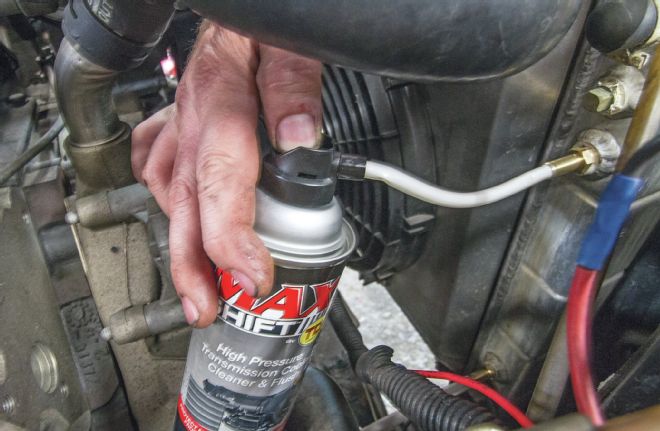 Rollings flushed the cooler with two cans of TCI Max Shift high-pressure cleaner. The kit comes with lines and fittings that connect directly to the cooler. Its patented high-pressure cleaning agent expands when it comes in contact with the air, backflushing the system to remove any harmful metal shavings and sludge.
Rollings flushed the cooler with two cans of TCI Max Shift high-pressure cleaner. The kit comes with lines and fittings that connect directly to the cooler. Its patented high-pressure cleaning agent expands when it comes in contact with the air, backflushing the system to remove any harmful metal shavings and sludge.
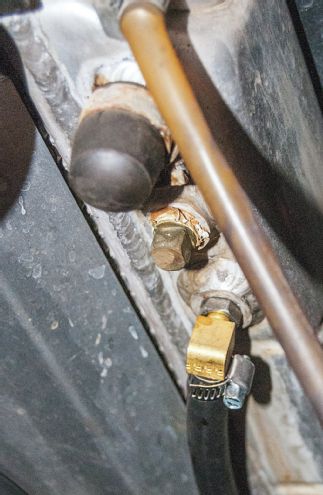 After flushing the system, Rollings installed the new high-pressure hose and fittings into the radiator. The trans outlet line goes to the lower fitting; the upper fitting is for the return line.
After flushing the system, Rollings installed the new high-pressure hose and fittings into the radiator. The trans outlet line goes to the lower fitting; the upper fitting is for the return line.
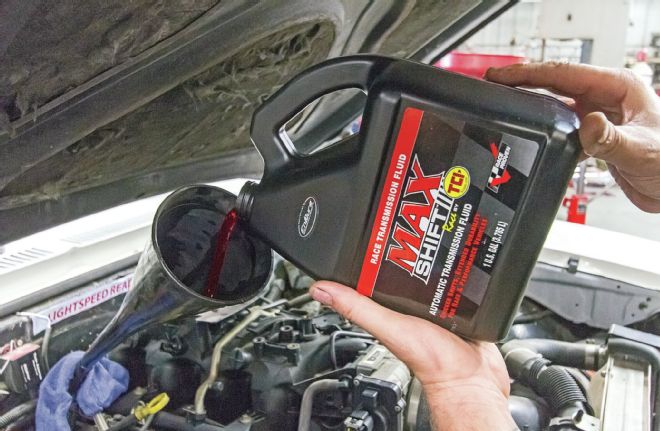 Finally, the system was filled with 3 gallons of Max Shift race transmission fluid. Fully compatible with GM Dexron and Ford Mercon fluid, Max Shift is fortified with ultra-pure base oils that resist viscosity breakdown to extend fluid change intervals. The formulation reduces internal friction and heat buildup while promoting quicker clutch lock-up for firmer shifts.
Finally, the system was filled with 3 gallons of Max Shift race transmission fluid. Fully compatible with GM Dexron and Ford Mercon fluid, Max Shift is fortified with ultra-pure base oils that resist viscosity breakdown to extend fluid change intervals. The formulation reduces internal friction and heat buildup while promoting quicker clutch lock-up for firmer shifts.
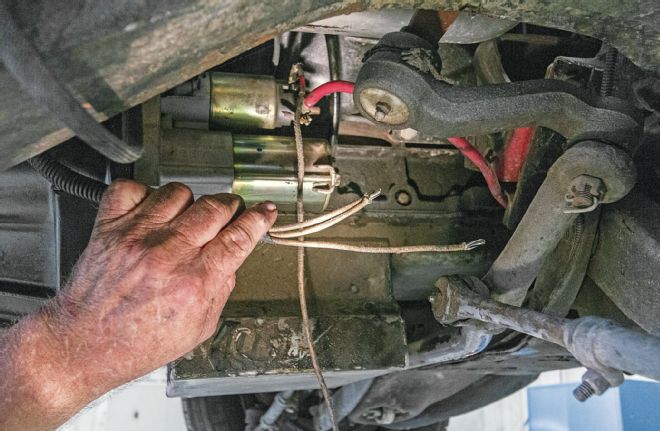 While he was bending up the new fluid lines, Norm noticed the dangling engine starter wire harness. “I couldn’t just let that lie,” remarked the meticulous mechanic. “I cut 1 foot out of the wires, cleaned up the routing, and secured everything out of the way.”
While he was bending up the new fluid lines, Norm noticed the dangling engine starter wire harness. “I couldn’t just let that lie,” remarked the meticulous mechanic. “I cut 1 foot out of the wires, cleaned up the routing, and secured everything out of the way.”
The noise is gone: Bees’ Nova no longer buzzes, and it shifts much firmer.“It’s awesome!” exults a satisfied Bees. Realistically, we don’t know if it was something in the trans or converter (later teardown failed to identify any specific “fatal” issue), the crudely mashed lines, the screen filters, or some combination of “all of the above.” What we do know is that the car is not only fixed for good, but overall it performs better than ever before.
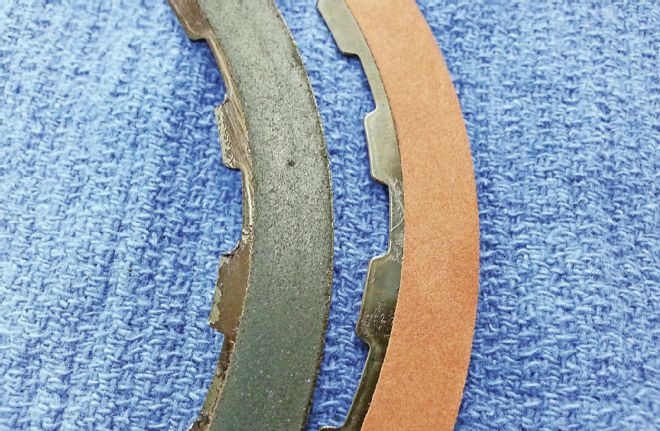 Rollings later tore down the trans for inspection. This requires special tools that the average home mechanic isn’t likely to have. For example, just to remove the bellhousing from the main case requires a special T-1550-style Torx Plus socket with extra-long flutes (left, versus standard, right).
Rollings later tore down the trans for inspection. This requires special tools that the average home mechanic isn’t likely to have. For example, just to remove the bellhousing from the main case requires a special T-1550-style Torx Plus socket with extra-long flutes (left, versus standard, right).
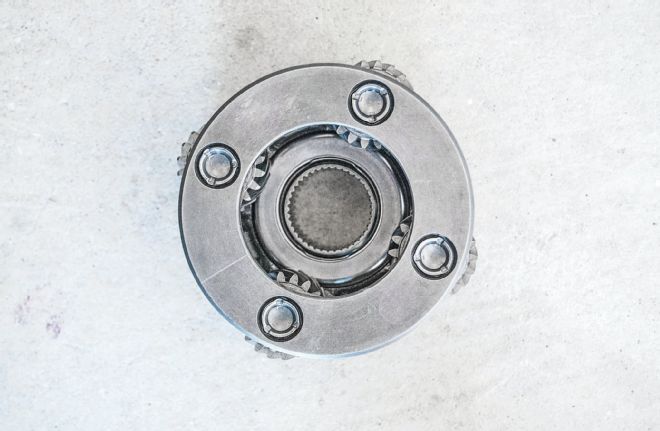 Four C’s Nieto says the most likely internal trans culprit for a buzzing sound is bad input carrier assembly needle bearings. Check with an expedient tool that fits snuggly in the carrier’s center hole. (Sanchez says a Ford C4 extension housing bushing works). Press down hard while rotating the gears. They should turn glass-smooth. The carrier assembly is serviced only as a complete unit. Bees’ carrier was fine.
Four C’s Nieto says the most likely internal trans culprit for a buzzing sound is bad input carrier assembly needle bearings. Check with an expedient tool that fits snuggly in the carrier’s center hole. (Sanchez says a Ford C4 extension housing bushing works). Press down hard while rotating the gears. They should turn glass-smooth. The carrier assembly is serviced only as a complete unit. Bees’ carrier was fine.
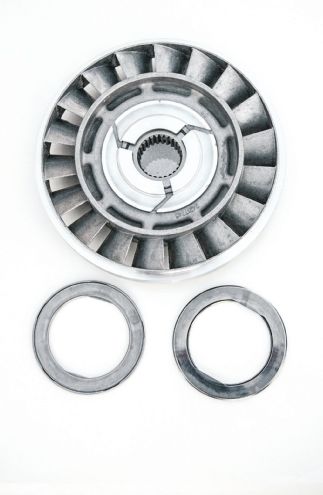 Bad torque converter internal roller bearings can also cause a buzzing sound. Power-brake the car in Drive. An audible noise when you release the throttle indicates one or both torque converter bearings are going away. But the only way to know for sure is to cut the converter open. Bees old converter also checked out OK.
Bad torque converter internal roller bearings can also cause a buzzing sound. Power-brake the car in Drive. An audible noise when you release the throttle indicates one or both torque converter bearings are going away. But the only way to know for sure is to cut the converter open. Bees old converter also checked out OK.
 The most serious wear in Bees’ old trans was the 3–4 clutch pack teeth (left, versus brand-new, right). Nieto and Rollings agree this amount of wear is not an immediate deal-breaker and probably wasn’t the cause of Bees’ noise, either. Go figure.
The most serious wear in Bees’ old trans was the 3–4 clutch pack teeth (left, versus brand-new, right). Nieto and Rollings agree this amount of wear is not an immediate deal-breaker and probably wasn’t the cause of Bees’ noise, either. Go figure.
Don’t skimp on the details. Be sure there are no restrictions between the trans and cooler that inhibit oil flow. Don’t shy away from making new transmission lines using the proper tubing, fittings, and/or hydraulic-rated hose. Never use screen-type filters. For reference, Four C’s Nieto says the lines, fittings, and cooler “must be capable of flowing a minimum of 1 quart of ATF in 30 seconds.”
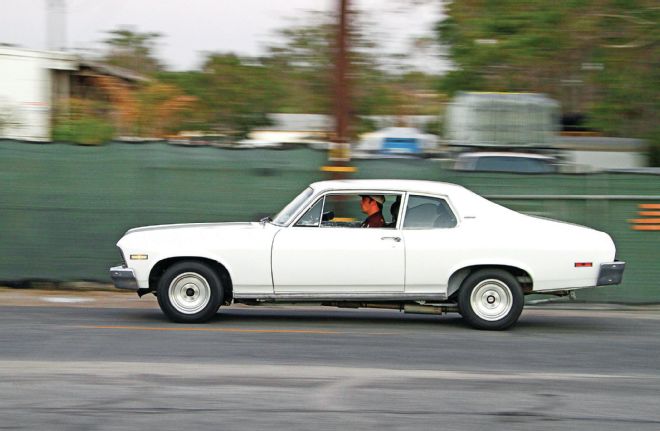 Problem solved, Bees can now get busy buzzing the Nova around his Mira Loma, California, hive on a daily basis.
Problem solved, Bees can now get busy buzzing the Nova around his Mira Loma, California, hive on a daily basis.
Parts And Prices Includes the major parts required to fix the problem. Does not include miscellaneous small parts, labor, shipping, or sales taxes. Priced 10/12/14 and subject to change. All dimensions are in linear inches or fractions thereof unless otherwise noted. Brand Part Description Part No. AMT. Price Source Cost ATP Gasket, transmission oil pan, molded rubber/steel composition JG-107 1 RockAuto $2.86 Dorman Drain Plug Kit, universal, ½-20 male x 1⁄8 NPT female, 9⁄16 wrenching hex¹ 65128 1 RockAuto $3.64 Edelmann Adapter, straight, SAE 45° IF female 5⁄16 tube ½-20 x 5⁄16 hose barb 824550 2 Autoplicity $3.64 Adapter, straight, SAE 45° IF male 5⁄16 tube ½-20 x 5⁄16 hose barb 821550 1 Autoplicity $2.52 Elbow, 90° swivel, SAE 45° IF male 5⁄16 tube ½-20 x 5⁄16 hose barb 822550 1 Autoplicity $12.28 Tubing ASM., mild steel, 5⁄16 od x 0.028 wall x 60 OL, w/ SAE 45° IF nuts and double flares 560ST 2 Autoplicity $6.26 Gates Hose, hydraulic fluid, SAE J1019, 5⁄16 ID, bulk 27058 4 Ft² O’Reilly $13.56 MasterPro³ CLAMP, band, stainless steel, SAE size 4 (0.25–0.625 range), 4/pack MP6202V 1 O’Reilly $2.99 Nook & Tranny Adapter Kit, SAE 45-degree IF 5⁄16 tube ½-20 female to 1⁄8-18 NPSM male (2/pack)4 FT2000 1 Nook & Tranny $14.00 TCI Cleaner & Flush Kit, transmission, Max Shift High-Pressure, SAE 45° IF 5⁄16 fittings, 2/pack 883004 1 Summit $25.97 Fluid, transmission hydraulic, Max Shift race, Dexron/Mercon-compatible, 1-gal. container 950601 3 Summit $71.91 Torque Converter, Breakaway, 4L60E/4L65E, 11" od w/ TCC lockup, ’99–’06 4.8/5.3/6.0L truck 242938 1 Summit $394.97 Transmission ASM., StreetFighter 4L60E/4L65E, ’00–’06 4.8/5.3/6.0L truck, 725 hp capacity 371016 1 Summit $2,495.27 Notes: ¹Used to mount trans temp gauge sending unit. ²Usually sold as a 25ft roll; 4 ft were purchased from the bulk reel at the local O’Reilly outlet. ³MasterPro is O’Reilly’s “house brand.” 4Kit converts trans fluid-line hook-ups from late-model Quick-Connects to traditional SAE 45-degree inverted-flare fittings. Total $3,049.87
Need Junk Fixed?
If your car has a gremlin that just won’t quit, you could be chosen for Hot Rod to the Rescue. Email us at pitstop@HotRod.com and put “Rescue” in the subject line. Include a description of your problem, your location, and a daytime phone number.